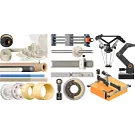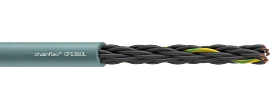Change Language :
Compare cables and save costs
In our product portfolio of over 1,350 chainflex cables, you will find various electrically identical cables with mechanical differences: from high-end cables to low-cost alternatives. Here you will find various solutions on how to select cost-effective cables and where the differences lie. This allows you to select exactly the cable that is suitable for your application and obtain the optimum price-performance ratio. All chainflex cables are specially developed and tested for use in the energy chain. In addition to control, data and measuring system cables, we also offer robot, servo and bus cables as well as fibre optic cables and special cables. All products are extensively tested in our 4,000m² test laboratory so that we can offer a 4-year guarantee on chainflex cables.
Find the best price-performance ratio now
98.50% savings for control cables: electrically identical - the bending is decisive
The available installation space in the machine often determines the bend radius of the cable in the energy chain. To ensure a long service life of the cable and save costs at the same time, it is crucial to choose the right bend radius for the respective application. The bend radius of our high-end CF98.PLUS cables of up to 3 x d allow problem-free use in the energy chain with limited installation space and are suitable for very fast applications, e.g. automatic doors or in semiconductor production. For many other indoor applications, e.g. indoor cranes or woodworking machines, a cable such as the CF880 with a larger bend radius can be selected to save costs.
Do you really need a control cable with a very small bend radius for your application or is a cable with a larger bend radius sufficient?
56.99% savings for control cables: electrically identical - the outer jacket makes the difference
Cables with PUR outer jacket are the right choice if they are used in applications and industries with dirty and oily ambient conditions in the energy chain. In machine tool construction or the automotive industry, the oil-resistant and notch-resistant material PUR is required to last a long time in continuous use in the energy chain. For dry environments with room temperature conditions, e.g. in the packaging or wood industry, the right and cost-effective solution is a cable with PVC outer jacket, which has very good abrasion properties in the energy chain.
Do you really need a control cable with PUR outer jacket for your application or is a cable with PVC outer jacket sufficient?
31.93% savings for motor cable: electrically identical - the sum of the cables is decisive
In many standardised industrial applications, multi-core cables are the most common choice that work well and last a long time. However, there is a cost-effective solution with several advantages. Due to the cost-effective manufacturing process, the price of single-core cables is lower than that of multi-core cables. In addition, the single-core solution is easier to install in the energy chain and can realise smaller installation spaces in the e-chain. Single cores are the right choice, especially for small installation spaces in the energy chain and for long travels.
Tip: When using single cores in the energy chain, the permissible current carrying capacity is almost 20% higher than with a stranded overall cable. This means that, depending on the application, a smaller cross section can be selected for the individual cores, which reduces costs and saves space and weight in the energy chain. Further information on the current carrying capacity can be found here.
Do you really need an overall cable for your application or is the solution with four individual cores not much better?
37.47% savings for servo cable: electrically identical - the travel is crucial
The travel length of the energy chain has a significant influence on the load on the cable used. For applications with long travel, e.g. for storage and retrieval machines or cranes, cables should be selected that have a gusset-filling extruded inner jacket or outer jacket. If no long travels are required, e.g. for machining units/machine tools, a cable without an inner jacket can bring the cost down.
Do you really need a cable with a very long travel (> 10 metres) for your application or is a cable for short travels sufficient?
73.07% savings with bus cable: the data volume is decisive
The secure and reliable transmission of data is becoming increasingly important. Ethernet cables are a widely used option because they offer a strong and fast connection that is essential for many applications. The most common categories, which we also offer in our product portfolio, are CAT5, CAT5e, CAT6, CAT6a and CAT7. The different categories indicate the frequencies and the possible data volume from 100Mbit to 10Gbit. With a data volume of 1Gbit , CAT5e is the most frequently used cable and offers a good price-performance ratio.
Do you really need a bus cable with a high data volume for your application or is a cable with a lower data volume sufficient?
Consulting
I look forward to answering your questions

Shipping and consultation
In person:
Monday to Friday from 8 am - 5 pm.









